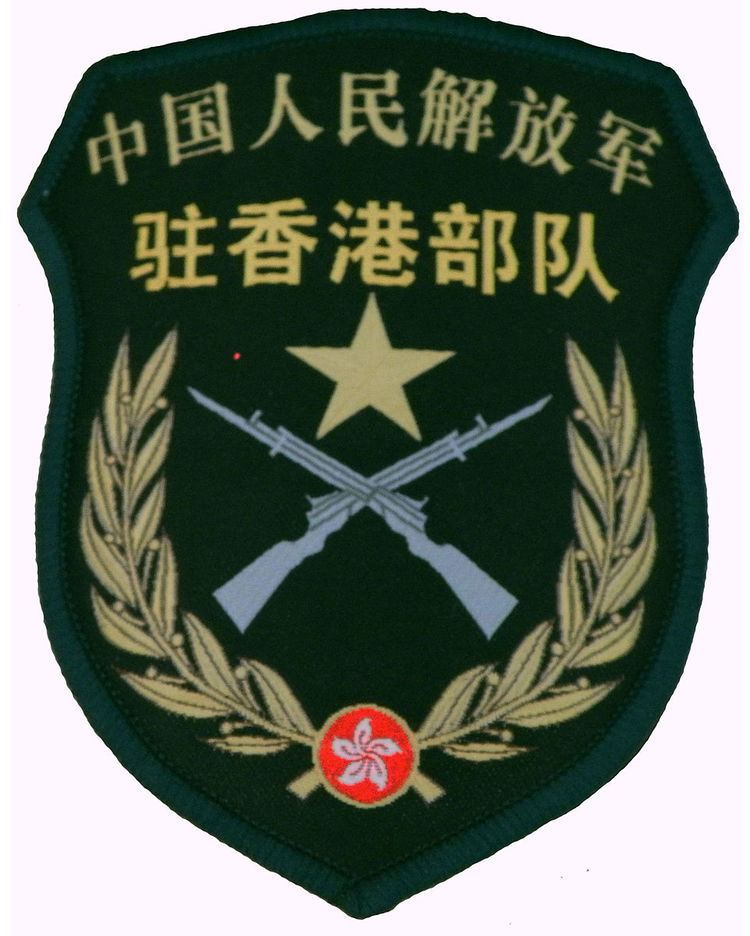Founded 1 July 1997 | Active personnel 6,000 | |
 | ||
Headquarters Chinese People's Liberation Army Forces Hong Kong Building Chief of Defense Lt. General Tan Benhong | ||
The People's Liberation Army Hong Kong Garrison is a garrison of the Chinese People's Liberation Army (PLA), responsible for defence duties in the Hong Kong Special Administrative Region since the sovereignty of Hong Kong was transferred to the PRC in 1997. Prior to the handover, Hong Kong was under British rule, and the defence of Hong Kong was the responsibility of the British Forces Overseas Hong Kong, with auxiliary help from the Royal Hong Kong Regiment.
Contents
- Role in Hong Kong
- Insignia
- Commanders Residence
- Command
- Garrison Commanders
- Political Commissars
- RegimentsUnits
- Bases
- Equipment
- Navy
- Squadrons
- Units
- References
As a non-sovereign territory, Hong Kong has never had a military force of its own. The garrison is headquartered in Chinese People's Liberation Army Forces Hong Kong Building in Central, Hong Kong. The troop strength of the garrison is about 6,000 personnel.
Role in Hong Kong
The Central People's Government (CPG) of the People's Republic of China (PRC) assumed sovereignty over Hong Kong on 1 July 1997 and stationed a garrison of the People's Liberation Army (PLA) in Hong Kong to manage its defence affairs. Although the garrison has no military significance, the stationing of the PLA troops in the region is a significant symbol of the PRC government's actual assumption of sovereignty over Hong Kong.
The Basic Law provides that the CPG shall be responsible for the defence of Hong Kong and shall bear the expenditure for the garrison, whereas the colonial Hong Kong Government before 1997 had to pay for the military. The Garrison Law, subsequently enacted by the National People's Congress, contains specific provisions on the duties and rules of discipline of the garrison personnel, jurisdiction and other questions, to facilitate the Hong Kong Garrison in fulfilling its defence functions along legal lines. Military forces stationed in Hong Kong shall not interfere in the local affairs and the Hong Kong government shall be responsible for the maintenance of public order. The Garrison formally stationed in Hong Kong assumed defence responsibility for Hong Kong starting midnight on 1 July 1997.
The Hong Kong Garrison includes elements of the People's Liberation Army Ground Force, PLA Navy, and PLA Air Force; these forces are under the direct leadership of the Central Military Commission in Beijing and under the administrative control of the adjacent Guangzhou Military Region.
While performing its defence duties, the Hong Kong Garrison must abide by both national and Hong Kong laws, as well as the current rules and regulations of the PLA. After its entry into Hong Kong, the Hong Kong Garrison abide by the Basic Law and the Garrison Law, actively organising military training. According to the Garrison Law, the Garrison established working contacts with the Hong Kong Government, and opened the barracks on Stonecutters Island and Stanley to the public to promote Hong Kong people's understanding of and trust in the garrison troops.
Insignia
Personnel in the Hong Kong Garrison wore uniforms different from their mainland counterparts until a new set of uniforms were introduced in 2007. Motor vehicles in the military are right-hand drive, like civilian vehicles in Hong Kong, and carry number plates that start with ZG, standing for zhùgǎng (驻港/駐港), Mandarin for "stationed in Hong Kong."
Commander's Residence
Commander's Residence is located at 11 Barker Road. Formerly known as Headquarters House, it was home to the Commander-in-Chief of British Forces from 1978 to 1997 and replaced the old Headquarter House or Flagstaff House c. 1840s.
A private road from Barker Road is used to access the home but is off limits to those without security clearance.
The residence is near two other official residences, Chief Secretary for Administration at 15 Barker Road and Secretary for Justice at 19 Severn Road.
Command
The Hong Kong Garrison reports to both the Southern Theater Command and Central Military Commission in Beijing, and informs Hong Kong Government of any actions within or around Hong Kong.
Garrison Commanders
- Lt. General Liu Zhenwu 1997–1999 (appointed 1994)
- Lt. General Xiong Ziren 1999–2004
- Lt. General Wang Jitang 2004–2008
- Lt. General Zhang Shibo 2008–2012
- Lt. General Wang Xiaojun 2012–2014
- Lt. General Tan Benhong 2014–present
Political Commissars
- Maj. General Xiong Ziren
- Maj. General Wang Yufa
- Maj. General Liu Liangkai
- Lt. General Zhang Rucheng
- Lt. General Liu Liangkai, second term
- Lt. General Wang Zengbo
- Lt. General Yue Shixin
Regiments/Units
Bases
Bases within Hong Kong are former British facilities namely from the British Army:
Equipment
Navy
The naval presence in Hong Kong is a limited sub-station with a small flotilla of ships rotating from bases in the mainland:
Squadrons
Bases
Units
Bases
PLA Hong Kong Garrison has three air bases with only one within Hong Kong:
